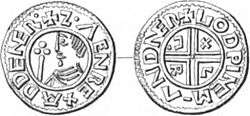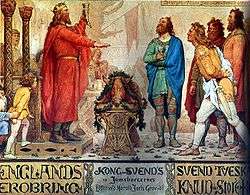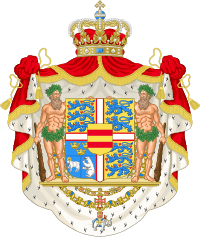Sweyn Forkbeard
Sweyn Forkbeard (/svɛn/;[1] Old Norse: Sveinn Haraldsson tjúguskegg;[2] Danish: Svend Tveskæg; 960 – 3 February 1014) was king of Denmark from 986 to 1014. He was the father of King Harald II of Denmark, King Cnut the Great and Queen Estrid Svendsdatter.
| Sweyn Forkbeard | |
|---|---|
 Sweyn (Suanus rex) invading England in 1013 (detail of a 13th-century miniature). Cambridge University Library. | |
| King of Denmark | |
| Reign | 986–1014 |
| Predecessor | Harald Bluetooth |
| Successor | Harald II |
| King of Norway | |
| Reign |
|
| Predecessor |
|
| Successor | Olaf II |
| King of England | |
| Reign | 1013–1014 |
| Predecessor | Æthelred |
| Successor | Æthelred |
| Born | c. 960 Denmark |
| Died | 3 February 1014 Gainsborough, Lincolnshire |
| Burial | Roskilde Cathedral or St. Trinity in Lund |
| Spouse | Świętosława / Sigrid/ Gunhild (detail) |
| Issue among others... |
|
| House | House of Denmark |
| Father | Harald Bluetooth |
| Mother | Gunhild or Tove |
In the mid-980s, Sweyn revolted against his father, Harald Bluetooth, and seized the throne. Harald was driven into exile and died shortly afterwards in November 986 or 987.[3] In 1000, with the allegiance of Trondejarl, Eric of Lade, Sweyn ruled most of Norway. In 1013, shortly before his death, he became the first Danish king of England after a long effort.
Biography

Historiographical sources on Sweyn's life include the Anglo-Saxon Chronicle (where his name is rendered as Swegen),[6] Adam of Bremen's 12th-century Deeds of the Bishops of Hamburg, and Snorri Sturluson's 13th-century Heimskringla.[7] Conflicting accounts of Sweyn's later life also appear in the Encomium Emmae Reginae, an 11th-century Latin encomium in honour of his son king Cnut's queen Emma of Normandy, along with Chronicon ex chronicis by Florence of Worcester, another 11th-century author.
Sweyn's father, Harald Bluetooth, was the first of the reigning Scandinavian kings to be baptised, in the early or mid-960s. According to Adam of Bremen, Harald's son Sweyn was baptised "Otto" (in honour of German king Otto I).[8] There are conflicting records as to the identity of his mother.[3] Adam of Bremen identifies her as "Gunhild", but some modern day scholars give her name as Tove from Western Wendland.[9] Sweyn married the widow of Erik, king of Sweden, named "Gunhild" in some sources,[9] or identified as an unnamed sister of Boleslav, ruler of Poland.[3]
Revolt and possible exile

In the mid-980s, Sweyn revolted against his father and seized the throne. Harald was driven into exile and died shortly afterwards in November 986 or 987.[3]
Adam of Bremen depicted Sweyn as a rebellious pagan who persecuted Christians, betrayed his father and expelled German bishops from Scania and Zealand. According to Adam, Sweyn was sent into exile by his father's German friends and deposed in favour of king Eric the Victorious of Sweden, whom Adam wrote ruled Denmark until his death in 994 or 995. Sørensen (2001) argues that Adam's depiction of Sweyn may be overly negative, as seen through an "unsympathetic and intolerant eye".[10] Adam's account is thus not seen as entirely reliable; the claimed 14-years' exile of Sweyn to Scotland does not seem to agree with Sweyn's building churches in Denmark throughout the same period, including the churches in Lund and Roskilde.[11] According to Adam, Sweyn was punished by God for leading the uprising which led to king Harald's death, and had to spend fourteen years abroad (i.e. 986–1000). The historicity of this exile, or its duration, is uncertain. Adam purports that Sweyn was shunned by all those with whom he sought refuge, but was finally allowed to live for a while in Scotland. Adam also suggests that Sweyn in his youth lived among heathens, and only achieved success as a ruler after accepting Christianity.
Battle of Svolder

Harald Bluetooth had already established a foothold in Norway, controlling Viken in c. 970. He may, however, have lost control over his Norwegian claims following his defeat against a German army in 974.
Sweyn built an alliance with Swedish king Olof Skötkonung and Eirik Hákonarson, Jarl of Lade, against Norwegian king Olaf Tryggvason. The Kings' sagas ascribe the causes of the alliance to Olaf Tryggvason's ill-fated marriage proposal to Sigrid the Haughty and his problematic marriage to Thyri, sister of Svein Forkbeard.
The allies attacked and defeated king Olaf in the western Baltic Sea when he was sailing home from an expedition, in the Battle of Svolder, fought in September of either 999 or 1000. The victors divided Norway among them. According to the account of the Heimskringla, Sweyn re-gained direct control of Viken district.
King Olaf of Sweden received four districts in Trondheim as well as Møre, Romsdal and Rånrike (the Fagrskinna, by contrast, says that the Swedish part consisted of Oppland and a part of Trondheim). He gave these to his son in law, Jarl Svein Hákonarson, to hold as a vassal. The rest of Norway was ruled by Eirik Hákonarson as King Svein's vassal.
The Jarls Eirik and Svein proved strong, competent rulers, and their reign was prosperous. Most sources say that they adopted Christianity but allowed the people religious freedom, leading to a backlash against Christianity which undid much of Olaf Tryggvason's missionary work.[12]
Religion
Sweyn apparently recruited priests and bishops from England, in preference to the Archbishopric of Bremen. In part, this reflected the fact that there were numerous Christian priests of Danish origin in the Danelaw, while Sweyn had few personal connections to Germany. However, Sweyn's preference for the English church may also have had a political motive, because German bishops were an integral part of the state. It suggested that Sweyn was seeking to pre-empt any diminution of his independence, by German leaders.[13] This may have been a reason for Adam of Bremen's apparent hostility in his accounts of Sweyn; by accentuating English ecclesiastical influence in his kingdom, Sweyn was effectively spurning the Archbishop of Bremen.
Invasions of England
The "Chronicle of John of Wallingford" (c. 1225–1250) records Sweyn's involvement in raids against England during 1002–1005, 1006–1007, and 1009–1012 to avenge the St. Brice's Day massacre of England's Danish inhabitants in November 1002. According to Ashley (1998), Sweyn's invasion was partly motivated by the massacre of Danes in England ordered by Æthelred the Unready in 1002, in which his sister and brother-in-law are said to have been killed.[14] but Lund (2001) argues that the main motivation for the raids was more likely the prospect of revenue.[11]
Sweyn campaigned in Wessex and East Anglia in 1003–1004, but a famine forced him to return to Denmark in 1005. Further raids took place in 1006–1007, and in 1009–1012 Thorkell the Tall led a Viking invasion into England. Simon Keynes regards it as uncertain whether Sweyn supported these invasions, but "whatever the case, he was quick to exploit the disruption caused by the activities of Thorkell's army".[15] Sweyn acquired massive sums of Danegeld through the raids. In 1013, he is reported to have personally led his forces in a full-scale invasion of England.[16]
The contemporary Peterborough Chronicle (part of the Anglo-Saxon Chronicle) states:
before the month of August came king Sweyn with his fleet to Sandwich. He went very quickly about East Anglia into the Humber's mouth, and so upward along the Trent till he came to Gainsborough. Earl Uchtred and all Northumbria quickly bowed to him, as did all the people of the Kingdom of Lindsey, then the people of the Five Boroughs. He was given hostages from each shire. When he understood that all the people had submitted to him, he bade that his force should be provisioned and horsed; he went south with the main part of the invasion force, while some of the invasion force, as well as the hostages, were with his son Cnut. After he came over Watling Street, they went to Oxford, and the town-dwellers soon bowed to him, and gave hostages. From there they went to Winchester, and the people did the same, then eastward to London.[17]
But the Londoners put up a strong resistance, because King Æthelred and Thorkell the Tall, a Viking leader who had defected to Æthelred, personally held their ground against him in London itself. Sweyn then went west to Bath, where the western thanes submitted to him and gave hostages. The Londoners then followed suit, fearing Sweyn's revenge if they resisted any longer. King Æthelred sent his sons Edward and Alfred to Normandy, and himself retreated to the Isle of Wight, and then followed them into exile.[17] On Christmas Day 1013 Sweyn was declared King of England.
Based in Gainsborough, Lincolnshire, Sweyn began to organise his vast new kingdom, but he died there on 3 February 1014, having ruled England for only five weeks. His embalmed body was returned to Denmark for burial in the church he had built. Tradition locates this church in Roskilde,[15] but it is more plausible that it was actually located in Lund in Scania (now part of Sweden).[18]
Aftermath
Sweyn's elder son, Harald II, succeeded him as King of Denmark, while his younger son, Cnut, was proclaimed King of England by the people of the Danelaw. However, the English nobility sent for Æthelred, who upon his return from exile in Normandy in the spring of 1014 managed to drive Cnut out of England. Cnut soon returned and became king of all England in 1016, following the deaths of Æthelred and his son Edmund Ironside; he succeeded his brother as King of Denmark in 1019 and eventually also ruled Norway, parts of Sweden, Pomerania, and Schleswig.
Cnut and his sons, Harold Harefoot and Harthacnut, ruled England over a combined 26-year period (1016–1042). After Harthacnut's death, the English throne reverted to the House of Wessex under Æthelred's younger son Edward the Confessor (reigned 1042–1066).
Sweyn's daughter, Estrid Svendsdatter, was the mother of King Sweyn II of Denmark. Her descendants continue to reign in Denmark to this day. One of them, Margaret of Denmark, married James III of Scotland in 1469, introducing Sweyn's bloodline into the Scottish royal house. After James VI of Scotland inherited the English throne in 1603, Sweyn's descendants became monarchs of England again.
Issue
Sweyn had eight children with Sigrid the Haughty and Gunhild of Wenden:
- Harald II of Denmark
- Cnut the Great
- Estrid Svendsdatter
- Gytha
- Gunnhild
- Santslaue
- Thyra
References
- "How to say or pronounce Sweyn". pronouncenames.com. Retrieved 17 March 2020.
- Svæinn Harallz sunr; Latinized forms of the name Sveinn are Suanus, Suenus, or Sveinus (Haraldi filius). The nickname tjúguskegg is a compound of tjúga "fork" and skegg "beard". Sweyn is so named in Fagrskinna chapters 27 and 41 (ed. Finnur Jónsson 1902–8, pp. 161, 206), in both cases in references to Astriðr dottor Svæins tiuguskægs.
- Sawyer, P. H. (23 September 2004). "Swein (Sveinn Haraldsson, Sveinn Tjúguskegg, Swein Forkbeard) (d. 1014), king of England and of Denmark". Oxford Dictionary of National Biography (online ed.). Oxford University Press. doi:10.1093/ref:odnb/26830. (Subscription or UK public library membership required.)
- Bolton, Timothy (2009). The Empire of Cnut the Great: Conquest and the Consolidation of Power in Northern Europe in the Early Eleventh Century. BRILL. pp. 162–. ISBN 90-04-16670-X.
- Hybel, Nils; Poulsen, Bjorn (2007). The Danish Resources c. 1000-1550: Growth and Recession. BRILL. pp. 86–. ISBN 978-90-474-2204-4.
- The Anglo-Saxon Chronicle. Manuscripts C, D, and E. Edited by Jebson, Tony. Accessed 18 August 2011.
- Howard, Ian (2003). Swein Forkbeard's Invasions and the Danish Conquest of England, 991– 1017. Woodbridge: Boydell Press. pp. 7–8. ISBN 0-85115-928-1.
- Adam of Bremen Gesta II.3. Ed. Schmeidler, trans. Tschan, pg. 56
- "Svend 1. Tveskæg". Den Store Danske. Retrieved 27 February 2013.
- Sørensen, M.P. (2001). "Religions Old and New", The Oxford Illustrated History of the Vikings. Ed. P.H. Sawyer. Oxford University Press (2001), pg. 202
- Lund, Niels (2001). "The Danish Empire and the End of the Viking Age", The Oxford Illustrated History of the Vikings. Ed. P. H. Sawyer. Oxford University Press, 2001, p. 167–181. ISBN 0-19-285434-8.
- This is according to Heimskringla and Fagrskinna, see Lee M. Hollander (trans.) (1991) Heimskringla, p. 244 and Finlay Finlay, Alison (editor and translator) (2004) Fagrskinna, p. 130. According to Historia Norwegie and Ágrip, the Jarls actively worked to uproot Christianity in Norway, see Driscoll, M.J. (editor) (1995). Ágrip af Nóregskonungasǫgum. Viking Society for Northern Research, p. 35 and Ekrem, Inger (editor), Lars Boje Mortensen (editor) and Peter Fisher (translator) (2003). Historia Norwegie (2003), p. 101.
- Lund, Niels (1986). "The armies of Swein Forkbeard and Cnut: leding or li(th)" Anglo-Saxon England 15 (1986), p. 39–40The Christianization of Scandinavia, Birgit Sawyer, et al., ed. Kungälv: Viktoria Bokforlag, p. 80. ISBN 91-86708-04-X.
- Mike Ashley, British Monarchs; A complete genealogy, gazetteer and biographical Encyclopaedia of the Kings and Queens of Britain, Robinson Publishing (1998) p.483: "Probably his [Æthelred's] worst decision was the St. Brice's day massacre on 13 November 1002...he ordered the killing of every Dane who lived in England, except the Anglo-Danes in the Danelaw. The massacre brought back to English shores the Danish commander Swein, whose sister and brother-in-law had been killed in the massacre".
- Keynes, Simon (2001). "Swein Forkbeard". In Lapidge, Michael; Blair, John; Scragg, Donald (eds.). The Blackwell Encyclopaedia of Anglo-Saxon England. London: Blackwell Publishing. p. 437. ISBN 0-631-15565-1.CS1 maint: uses editors parameter (link)
- Blair, Peter Hunter (2003). An Introduction to Anglo-Saxon England (3rd ed.). Cambridge University Press. p. 98. ISBN 0-521-53777-0.
- The Anglo-Saxon Chronicle. Everyman Press: London, 1912. Translation by James Ingram (London, 1823) and J. A. Giles (London, 1847). Medieval and Classical Literature Library Release #17. Retrieved 12 October 2006.
- "Sweyn Forkbeard". Medieval Histories. 4 February 2014. Retrieved 9 March 2017.
External links
| Wikimedia Commons has media related to Sweyn Forkbeard. |
- Swein 1 at Prosopography of Anglo-Saxon England
- Northvegr (Scandinavian) – A History of the Vikings (Search)
- Vikingworld (Danish) – Swein Forkbeard (Svend Tveskæg)
- Sweyn Forkbeard: The Viking King of England on Medieval Archives Podcast
| Regnal titles | ||
|---|---|---|
| Preceded by Harald Bluetooth |
King of Denmark c. 985–1014 |
Succeeded by Harald II |
| King of Norway c. 985–995 |
Succeeded by Olaf I | |
| Preceded by Olaf I |
King of Norway 1000–1014 |
Succeeded by Olaf II |
| Preceded by Æthelred the Unready |
King of the English 1013–1014 |
Succeeded by Æthelred the Unready |
